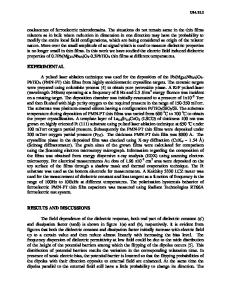Orientation-Dependent Dielectric Anomalies in Relaxor-Based Crystal (PbMg 1/3 Nb 2/3 O 3 ) 0.68 (PbTiO 3 ) 0.32 (PMN-32%
- PDF / 239,373 Bytes
- 5 Pages / 612 x 792 pts (letter) Page_size
- 8 Downloads / 304 Views
Orientation-Dependent Dielectric Anomalies in Relaxor-Based Crystal (PbMg1/3Nb2/3O3)0.68(PbTiO3)0.32 (PMN-32%PT) Chi-Shun Tu1 and V. Hugo Schmidt2 1 Department of Physics, Fu Jen University, Taipei 242, Taiwan 2 Department of Physics, Montana State University, Bozeman, MT 59717, U.S.A. ABSTRACT Dielectric permittivities and polarization-electric-field (P-E) hysteresis loops have been measured as a function of temperature in relaxor-based ferroelectric single crystals (PbMg1/3Nb2/3O3)0.68(PbTiO3)0.32 (PMN-32%PT) for cub and cub orientations. Contrary to the pure PbMg1/3Nb2/3O3 (PMN), PMN-32%PT exhibits apparent orientation dependences of dielectric permittivities, polarizations, and phase transitions. With a prior fieldcooled treatment, a field-induced state, perhaps of orthorhombic symmetry, is evidenced and coexists with the rhombohedral symmetry in the low-temperature region. This field-induced phase is manifested by an extra dielectric peak observed near 373 K for the cub orientation.
INTRODUCTION (PbMg1/3Nb2/3O3)1-x(PbTiO3)x (PMN-xPT) has a morphotropic phase boundary (MPB) in the range ∼28 to ∼36 mol% PT.1 As temperature decreases, PMN-xPT crystals (0.28≤x≤0.36) exhibit successive phase transitions: cubic paraelectric phase → tetragonal ferroelectric (FE) phase → rhombohedral FE phase, that for x=0.32 occur at 410-420 K and 360-380 K respectively. These are not normal phase transitions with sharply defined transition temperatures. In relaxors, the low-temperature symmetry is broken by quenched disorder. From the E-field-dependent polarization result, a metastable intermediate orthorhombic FE phase (between rhombohedral and tetragonal states) was recently proposed in the PZN-8%PT crystal.2 PMN-PT crystals exhibit high electromechanical coupling factors and their piezoelectric performance is crucial in applications of telecommunication and ultrasonic devices. The fieldinduced transformation, phase coexistence and orientation play important roles in the electromechanical coupling effect. However, limited attention has been paid to the above phenomena, especially near the MPB.3-5 Thus, we carried out dielectric permittivity and P-E hysteresis loop experiments. EXPERIMENTAL PROCEDURE The lead magnesium niobate-lead titanate single crystal PMN-32%PT was grown using a modified Bridgman method.6 Samples were cut perpendicular to the cub and cub directions. Here, direction “< >cub” refers to the pseudocubic axes. Physical analysis by the JEOL6100 electron microscope has been used to determine local B-site-ion concentration. In the PMN-32%PT platelets, the Ti4+ concentration of each sample varies by about ±2% from its nominal composition. The average Ti4+ concentration of the cub oriented sample is slightly larger (about 0.3%) than the value of the cub oriented sample. For dielectric permittivity D10.23.1 Downloaded from https://www.cambridge.org/core. Columbia University - Law Library, on 17 Aug 2019 at 01:09:43, subject to the Cambridge Core terms of use, available at https://www.cambridge.org/core/terms. https://doi.
Data Loading...











